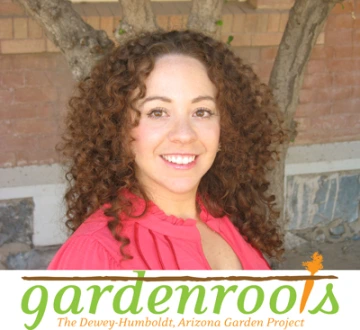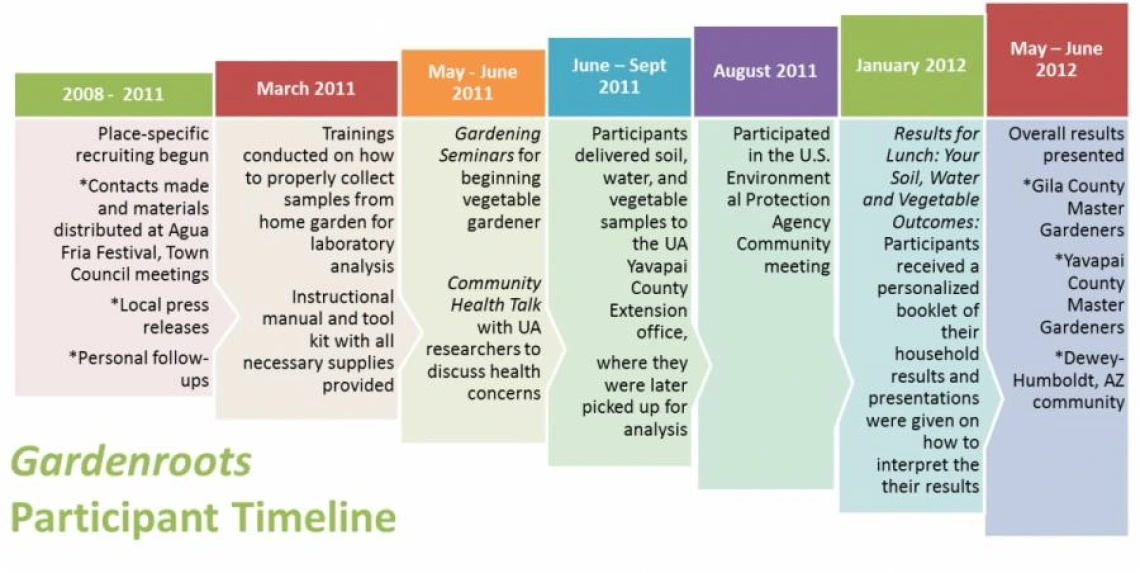
Gardenroots was developed by Mónica Ramírez-Andreotta, Superfund Research Program Training Core graduate student and former Research Translation Coordinator. She created the project in response to home gardening concerns in the Dewey-Humboldt, AZ community over possible metal contamination from the neighboring Iron King Mine and Humboldt Smelter Superfund site.
The overall objective of Gardenroots was to determine whether home garden vegetables grown in Dewey-Humboldt had elevated levels of arsenic. By building co-created public participation in a scientific research program, this project also looked to educate, build human capacity, and increase community networking in resource-related issues in the community.
Check out the Gardenroots website.
Objectives/Methods
Gardenroots combined a home garden experiment with controlled greenhouse studies to meet the following project objectives:
- Develop a citizen-science program to inform and engage community members
- Recruit at the local level
- Provide training and educational activities for participants (see below for timeline)
- Characterize arsenic uptake in homegrown and greenhouse-grown vegetables
- Home gardens (citizen-scientists): collect soil, water, and vegetable samples (of their choice)
- Greenhouse: grow vegetables in soils with known concentrations of arsenic
- Analyze water, soil, and vegetable samples for arsenic concentration
- Estimate arsenic exposure and characterize potential risk
- Combine measured arsenic concentrations with reported U.S. intake rates
- Use exposure assessment modeling to estimate average daily dose of arsenic from vegetable, soil, and water (assuming the primary source of water for irrigation is also used for drinking) and associated potential risks
- Report results back to participants in an effective and meaningful way
- Provide personalized results and estimated risks that allow individual participants to make educated choices
- Provide aggregate overview of community and greenhouse results
- Develop recommended best practices handouts:
For additional details, please refer to Dr. Ramírez-Andreotta’s publications:
- A greenhouse and field-based study to determine the accumulation of arsenic in common homegrown vegetables grown in mining-affected soils. Sci Total Environ. 2013 Jan 15;443:299-306. Download the PDF
- Home gardening near a mining site in an arsenic-endemic region of Arizona: Assessing arsenic exposure dose and risk via ingestion of home garden vegetables, soils, and water. Sci Total Environ. 2013 June 1;454-455:373–382. Download the PDF
- Building a co-created citizen science program with gardeners neighboring a Superfund site: The Gardenroots case study. In: Public Health: Improving Health via Inter-Professional Collaborations, NY: Nova Science Publishers, Eds: Caron RM and Merrick J. 2014. Download the PDF
Timeline
In March of 2008, the Iron King Mine Humboldt Smelter Superfund site in Dewey-Humboldt, AZ was added to the U.S. Environmental Protections Agency (EPA) National Priorities List. At a U.S. EPA meeting in August 2008, members of the community asked whether it was safe to grow and consume vegetables from their garden. To answer this question, former Research Translation Coordinator Mónica Ramírez-Andreotta embarked on her doctoral career and began seeking funding. In 2010, residential soils were collected for greenhouse studies and local recruitment of gardeners to participate in the Gardenroots study began. Training sessions were held in March 2011, to instruct citizen-scientists in the collection of garden vegetables, as well as irrigation water and soil samples. Additional educational activities were offered, such as gardening seminars (May 2011), a community health talk with UA researchers (June 2011), and a tour of the UA laboratories where the concentrations of arsenic in the collected vegetable, water, and soil samples were being measured (Nov 2011). At the “Results for Lunch: Your Soil, Water and Vegetable Outcomes” luncheon (Jan 2012), participants were given personalized booklets showing the results for their individual gardens. Booklets included “raw” data (i.e. milligrams of arsenic per kilogram of vegetable, fresh weight), calculations of how much each participant could eat from his or her own garden at different levels of estimated risk, and estimated risks associated with individual water and soil samples. Handouts with recommended safe practices for gardening were also provided. A complete overview of the project was presented to Gardenroots participants and the Yavapai Master Gardeners (June 2012). In December 2012, overall project results handouts were sent to participants and other interested community members.

News and Highlights related to Gardenroots
- UA SRP Training Core Student Monica Ramirez Awarded NASA Space Grant Fellowship
- UA SRP Training Core Student Monica Ramirez-Andreotta Awarded EPA Grant for Gardenroots Project
- UA SRP Researchers Participate in Dewey-Humboldt Community Health Talk
- Chemical and Engineering News, “Crowdsourcing Chemistry”
- Gardenroots “Results for Lunch” Event a Success!
- Another Success for the 2011-2012 EPA-SRP Seminar Series!
- UA SRP Joins with Agencies for Community Meeting
- Trainee Sows Gardenroots Results Across Arizona
- Trainee Success Story: Mónica Ramírez-Andreotta
- Trainee Success Story: Mónica Ramírez-Andreotta Promoted
- NIEHS Environmental Factor, Wetterhahn awardee discusses community project on arsenic in vegetables
- NIEHS Superfund Research Program Research Brief 219: Arsenic Uptake in Homegrown Vegetables from Mining-Affected Soils
Made Possible By
- The Department of Environmental Science, The University of Arizona
- The College of Pharmacy, The University of Arizona
- Cooperative Extension, The University of Arizona
- Superfund Research Program
- The United States Environmental Protection Agency
- Arizona Space Grant Consortium
- Alfred P. Sloan Foundation
- NACME
- Water Sustainability Program
- Town of Dewey-Humboldt

